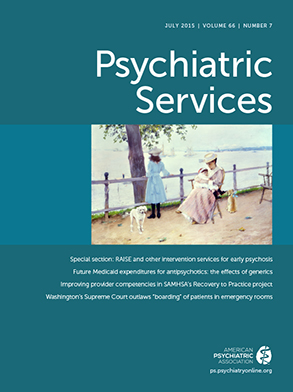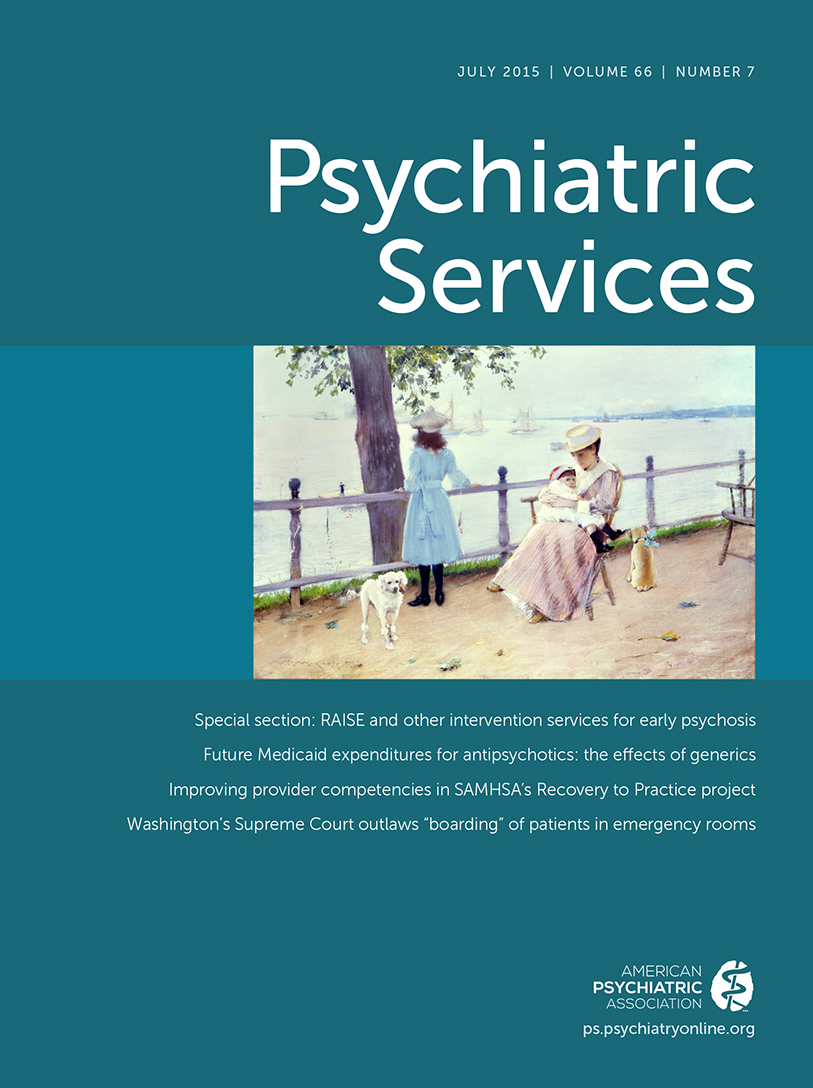Despite immigrants’ increased vulnerability to developing psychosis (
1), they are less likely to use mental health services than residents of the host country (
2,
3). Although early intervention services for psychosis have been shown to improve young people’s engagement in treatment, most studies have not documented the immigration status of participants (
4,
5). The aim of this study was to assess whether early intervention services for psychosis are successful in engaging immigrants in treatment by comparing their service disengagement rates and medication adherence rates to those of nonimmigrants during the two years after they entered an early intervention program.
Methods
A two-year longitudinal prospective cohort study of individuals with first-episode psychosis was conducted from 2005 to 2012 in two five-year early intervention programs in urban catchment areas of Montreal, Canada. Both programs offer specialized treatment based on early psychosis intervention guidelines to all persons with first-episode psychosis in their defined catchment areas (
6). [A description of the program is included in an
online supplement to this report.] To be included, patients had to be between the ages of 18 and 30, to have a primary diagnosis of a psychotic disorder, and to have had no treatment or less than one year of treatment. Patients with a developmental disability and inadequate proficiency in French or in English were excluded. The study received institutional ethics and scientific committee approval, and written informed consent was obtained from each participant.
Data on sociodemographic characteristics, diagnosis, symptoms, and social functioning were collected annually by participant interviews and file reviews. Medication adherence was assessed by asking the participant and his or her case manager and psychiatrist and by reviewing medical files. To allow calculation of the attrition rate, two-year follow-up status was categorized as followed up, lost to follow-up, and transferred to other services or deceased. Immigration status was divided into nonimmigrants (including mixed second-generation immigrants (one immigrant parent and one nonimmigrant parent), first-generation immigrants, and second-generation immigrants. [Additional information on group categorization is presented in the online supplement.]
Analyses were performed with SPSS software, version 20. Baseline characteristics, attrition rate, and medication adherence for first-generation and second-generation immigrants were compared with those of nonimmigrants. Analysis of variance was used for group comparisons for continuous variables, and Pearson’s chi square tests were used for discrete variables. Logistic regression analysis was conducted for the attrition rate differences between nonimmigrants and immigrants (first generation and second generation) while taking into account potential confounding factors (baseline group differences).
Results
A total of 223 participants were enrolled in the study. First-generation immigrants (N=54), second-generation immigrants (N=37), and nonimmigrants (N=129) entering the early intervention programs had similar baseline sociodemographic, clinical, and functioning profiles. However, compared with nonimmigrants, second-generation immigrants were more likely to be living with their families and first-generation immigrants were less likely be male and to have a substance use disorder. Also, nonimmigrants were more likely to have a higher Global Assessment of Functioning (GAF) score (better functioning) and a lifetime history of homelessness [see figure and tables in the online supplement].
The attrition rates at one and two years were significantly higher in immigrant groups (
Table 1). The difference remained when we excluded the nine mixed second-generation individuals from the nonimmigrant group (attrition rate at 12 months: nonimmigrants, 6%; immigrants, 18%; p=.009; at 24 months: nonimmigrants, 8%; immigrants, 22%; p=.005). To control for potential confounding, we tested three different outcome hypotheses for the participants transferred to other services (N=6): all were considered followed up, all were considered lost to follow-up, and all were excluded. Differences in attrition rates between immigrants and nonimmigrants remained significant in all three analytical scenarios, indicating that our results were robust despite the participants transferred to other services.
The logistic regression model (including immigration status and variables with differences at admission: gender, GAF score, substance use disorder, history of homelessness, and living arrangement) showed that immigrants had more than three times the odds of attrition than nonimmigrants. The difference was statistically significant for first-generation immigrants (odds ratio [OR]=3.11, 95% confidence interval [CI]=1.01–9.57, p=.049) and for second-generation immigrants (OR=3.65, CI=1.07–12.50, p=.039). Language status could not explain the variance because attrition rates were similar among participants whose native language was French or English and those whose native language was not French or English (22% and 25%, respectively).
Although medication adherence remained relatively high, it was similar for the three groups throughout the two-year follow-up, as were rates of injectable long-acting antipsychotic prescriptions and treatment orders (
Table 1).
Discussion
No association was found between immigration status and medication adherence among participants who remained in the early intervention programs. These findings are similar to those reported by Levy and colleagues (
7). The overall high rate of medication adherence suggests that these services are effective in promoting medication adherence among participants regardless of their immigrant status.
The social context of immigration and its associated precariousness may influence an individual’s ability and willingness to request mental health services and to pursue treatment. Various hypotheses may explain the higher attrition rate among immigrants: different health belief models (
8), experiences of discrimination and stigma (
9), and increased mobility of immigrants and sequential migration (
10) (especially among first-generation immigrants). After experiencing a first episode of psychosis in the host country, some immigrants may associate their new country with their problems and experience ambivalent feelings toward the host country. Support from people who share the same values and ethnic backgrounds is known to effectively buffer social stressors (
11). Moving elsewhere or back to the homeland may be a help-seeking pathway, especially if recovery is not achieved within the first year, which can also lead to an inability to keep up with student and work visa requirements.
Some studies point to the relationship between perceived discrimination and incidence of psychosis (
12). Immigrants with a first episode of psychosis may face a double stigma stemming from both immigration and psychosis. Family members may share some of the stigmatization because of their affiliation and kinship with the person with mental illness.
Even though early intervention services provide mental health care in a collaborative, nonjudgmental, and welcoming atmosphere, the ethnocultural knowledge of the care teams may be limited because ethnic and cultural differences are not taught in most clinical training. Therefore, the presence of other explanatory systems for the illness may not always be elicited by the care teams.
The therapeutic alliance, a cornerstone of medication adherence (
13), may be harder to build when the therapist and the patient have different health belief models (
14). Because immigrants in the first year of the early intervention programs quit treatment at a higher rate and earlier than nonimmigrants, the health care team may not have had the opportunity to build a strong therapeutic alliance to facilitate treatment retention.
Several limitations of this study must be considered. The exclusion of patients without a minimal mastery of the French or English language (less than 2% of the potential cohort) excluded a certain group of less integrated immigrants. Also, 20% of patients refused to participate in the study, which limits the conclusions and their generalizability; however, that proportion is similar to those in other studies of persons with first-episode psychosis (
14). Immigrants are a very heterogeneous group (for example, number of years since immigration at the time of the study, age at immigration, reasons for immigration, and immigration processes); however, we had no data to capture this heterogeneity, and those factors probably had an important impact on outcome. Furthermore, medication adherence was assessed by self-report or clinician estimates, which are known to overestimate adherence (
15).

